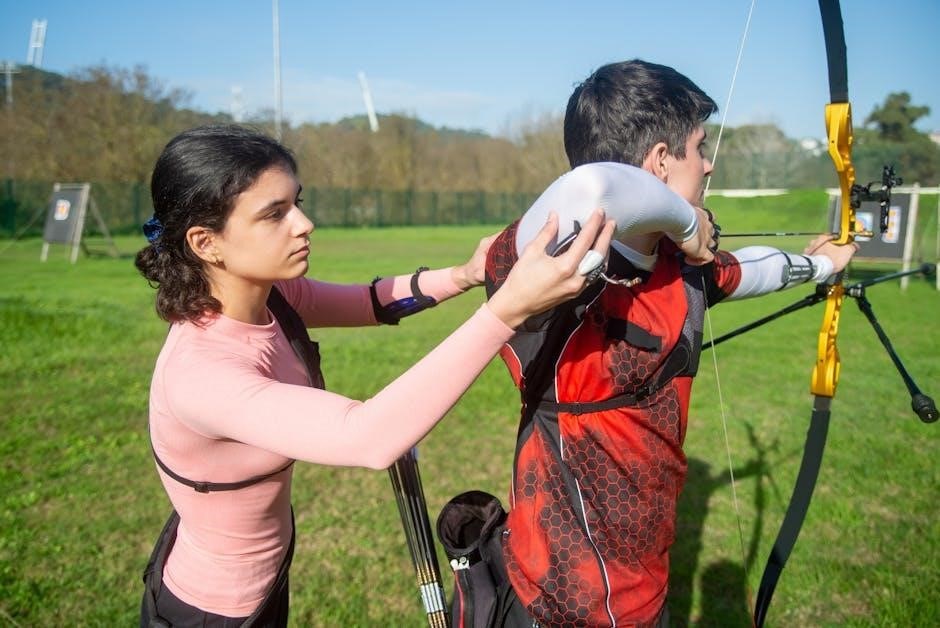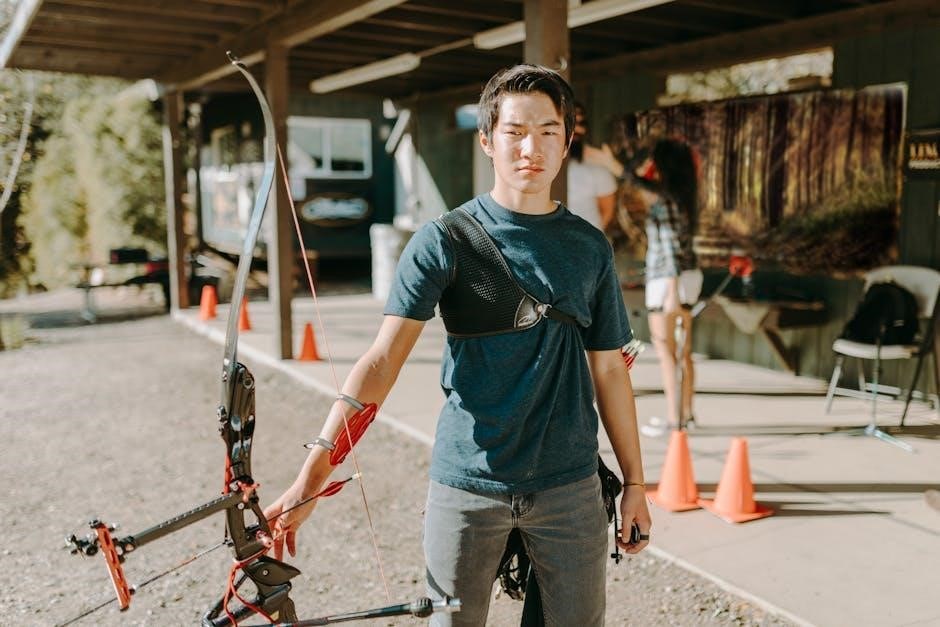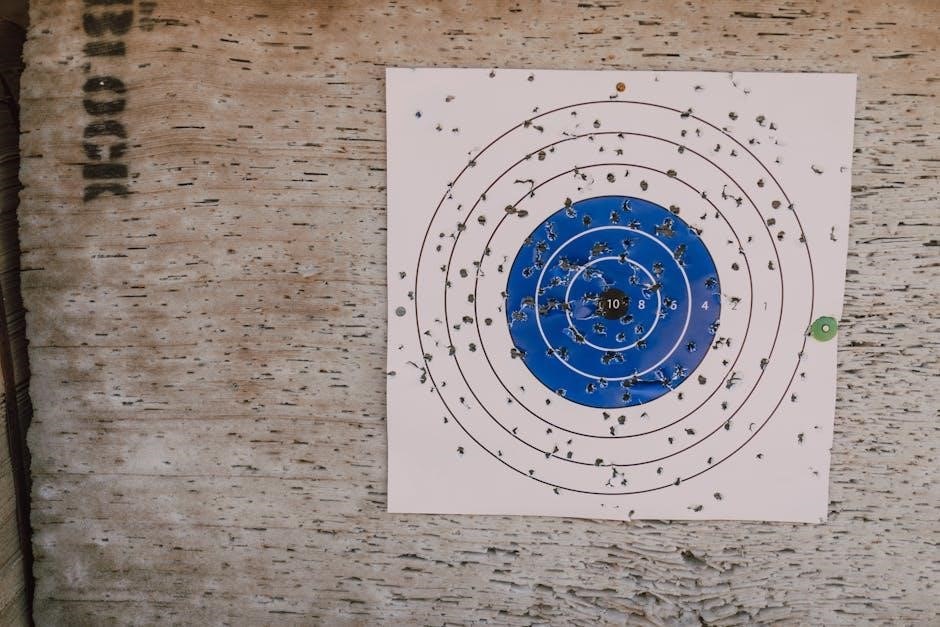Bow and Arrow Herbicide is a powerful solution for controlling broadleaf weeds in turf. It combines MCPA, Clopyralid, and Diflufenican to target weed growth effectively without harming grass.
1.1 Overview of Bow and Arrow Herbicide
Bow and Arrow Herbicide is a widely-used solution for controlling broadleaf weeds in turf. It combines MCPA, Clopyralid, and Diflufenican, which target weed growth systems, causing leaves to curl, yellow, and die over time. The herbicide is safe for use on various turf varieties, including Buffalo and Blue Couch. Application is straightforward but requires careful preparation and timing to ensure effectiveness and safety. Proper dilution and spraying techniques are essential for optimal results, making it a reliable choice for turf management.
1.2 Importance of Proper Usage Instructions
Adhering to the instructions for Bow and Arrow Herbicide is crucial for its effectiveness and safety. Proper usage ensures the herbicide targets weeds without harming turf. Incorrect application can lead to reduced efficacy or turf damage. Following guidelines, such as dilution rates, spray techniques, and timing, maximizes results. It’s also essential to avoid mowing before and after application to allow sufficient leaf absorption, ensuring the herbicide works effectively. Proper usage protects both the environment and desirable plants, making it a reliable solution for weed control.

Understanding the Active Ingredients
Bow and Arrow Herbicide contains MCPA, Clopyralid, and Diflufenican, which work together to target weed growth systems, causing them to curl, yellow, and die over time.
2.1 MCPA (Methylchlorophenoxyacetic Acid)
MCPA is a synthetic auxin herbicide, primarily targeting broadleaf weeds by mimicking natural plant hormones. It is absorbed through leaves and stems, disrupting cell elongation and causing curled, yellowed foliage before plant death. Effective against annual and perennial broadleaf weeds, MCPA is commonly used in turf management to control species like dandelions and clover. It exhibits selectivity for grasses such as Kentucky bluegrass and ryegrass when applied at recommended rates, making it a reliable choice for maintaining healthy turf. Proper application is essential to avoid injury to desirable plants.
2.2 Clopyralid
Clopyralid is a selective herbicide that targets broadleaf weeds by inhibiting cell growth and disrupting plant hormone activity. It is highly effective against perennial weeds like thistles and clover, making it a key component in turf management. Applied at recommended rates, it is generally safe for grasses but can harm sensitive plants if misused. Clopyralid works systemically, absorbed through leaves and stems, leading to gradual plant death. Proper application ensures effective weed control while minimizing risks to desirable vegetation.
2.3 Diflufenican
Diflufenican is a pre-emergence and post-emergence herbicide that inhibits protoporphyrinogen oxidase (PPO), disrupting photosynthesis in target weeds. It is effective against broadleaf weeds like pigweed and lamb’s quarters. Applied as a pre-mix in Bow and Arrow, it enhances weed control by preventing seed germination and killing emerging plants. Diflufenican is rainfast within hours, ensuring reliability in varying weather conditions. Proper application timing, especially during weed germination, maximizes its effectiveness while maintaining turf safety when used as directed.

Safety Precautions
Safety precautions are crucial when using Bow and Arrow Herbicide to protect users, the environment, and turf. Follow guidelines to minimize risks and ensure safe application.
3.1 Personal Protective Equipment (PPE)
When using Bow and Arrow Herbicide, wear long sleeves, pants, closed-toe shoes, gloves, safety goggles, and a face mask to prevent skin contact and inhalation. Ensure all PPE meets safety standards to protect against chemical exposure. Avoid eating, drinking, or smoking during application. Wash hands and clothing thoroughly after use to remove any potential residue. Proper PPE use minimizes health risks and ensures safe handling of the herbicide.
3.2 Avoiding Drift and Overspray
To prevent drift and overspray, apply Bow and Arrow Herbicide during calm or light wind conditions (less than 10 mph). Avoid spraying when plants are wet, as this increases runoff. Use low-pressure nozzles to minimize droplet formation. Maintain a safe distance from desirable plants and sensitive areas. Drift-control agents can also be used to reduce herbicide movement. Proper application techniques ensure target accuracy and minimize environmental impact, protecting non-target vegetation and ecosystems from unintended exposure.
3.3 Safe Storage and Disposal
Store Bow and Arrow Herbicide in its original container, tightly sealed, and in a cool, dry place away from direct sunlight. Keep it out of reach of children, pets, and unauthorized individuals. Dispose of unused product and empty containers according to local, state, and federal regulations. Do not pour leftover herbicide down drains or waterways, as it can harm aquatic life. Always follow the label instructions for safe disposal to protect the environment and public health.

Application Instructions
Follow label instructions for proper timing, equipment setup, and spray techniques. Apply when weeds are actively growing, ensuring accurate coverage and avoiding overspray. This ensures effectiveness and turf safety while minimizing environmental impact.
4.1 Equipment Preparation
Ensure all equipment is clean and in good working condition. Use a properly calibrated sprayer with appropriate nozzles (e.g., flat-fan or hollow-cone types) to achieve uniform coverage. Check and clean screens and nozzles to prevent clogging. Verify the sprayer’s calibration to deliver the correct application rate specified on the label. Prepare the tank by rinsing it thoroughly before adding the herbicide mixture. Always follow manufacturer guidelines for sprayer setup and maintenance to ensure accurate application and prevent drift or uneven distribution.
4.2 Mixing Rate and Ratio
Always follow the product label for specific mixing instructions. Typically, mix 0.5 to 1.0 fluid ounces of Bow and Arrow herbicide per acre in 15 to 30 gallons of water. Adjust rates based on target weed species and growth stage. Avoid exceeding the maximum labeled rate to prevent turf injury. Do not mix with other herbicides unless specified on the label. Ensure thorough agitation to maintain a uniform solution. Use the mixture within the same day to optimize effectiveness and prevent settling.
4.3 Timing of Application
Apply Bow and Arrow herbicide during early weed growth stages for optimal results. Target weeds when they are actively growing, typically in spring or early summer. Avoid application during extreme heat, drought, or when temperatures exceed 85°F. For best results, apply in the morning or late afternoon to minimize evaporation. The herbicide works within 7–14 days, providing systemic control. Ensure no rain or irrigation occurs within 24–48 hours after application to allow proper absorption. Timing is critical for effectiveness and turf safety.
4.4 Spray Technique
Use a calibrated sprayer to ensure accurate application rates. Maintain a spray pressure of 20–40 PSI for optimal coverage. Hold the nozzle 18–24 inches above the target area to minimize drift. Spray in a steady, overlapping pattern to achieve uniform coverage. Avoid spraying in windy conditions to prevent drift onto non-target plants. Do not apply in excess, as this can lead to runoff and reduced effectiveness. Proper technique ensures even distribution and minimizes environmental impact.

Target Weeds and Effectiveness
Effective against common broadleaf weeds like dandelions, clover, plantain, and chickweed. Controls unwanted growth without harming most grass types when applied correctly.
5.1 Broadleaf Weeds Controlled
Bow and Arrow Herbicide effectively targets a wide range of broadleaf weeds, including dandelions, clover, plantain, chickweed, and thistle. It inhibits weed growth by disrupting cellular processes, providing systemic control. The herbicide is particularly effective on young, actively growing weeds. Proper application ensures optimal results, with visible effects within days. It is designed to selectively control broadleaf species while maintaining the health of desirable grasses, making it a reliable choice for lawn and turf management.
5.2 Grass Safety
Bow and Arrow Herbicide is formulated to be safe for most common turfgrass species, including Kentucky bluegrass, perennial ryegrass, and tall fescue. When applied as directed, it selectively targets broadleaf weeds without harming grass. Proper application timing and adherence to label instructions ensure grass remains healthy. Avoid applying during extreme weather or when grass is under stress, such as drought or recent mowing. Correct usage maintains turf integrity and promotes a lush, weed-free lawn.
5.3 Results and Duration
Bow and Arrow Herbicide delivers visible results within 7–14 days, with full control achieved by 21 days. The active ingredients disrupt weed growth, leading to gradual wilting and death. Effectiveness lasts several weeks, depending on target species and application timing. For annual weeds, control may persist through the growing season, while perennials may require follow-up treatments. Proper application ensures long-lasting weed suppression, maintaining a clean and healthy turf environment.

Environmental Considerations
Bow and Arrow Herbicide affects turf varieties differently, requiring careful application to avoid harming desirable plants. It poses risks to wildlife and pets if misused, emphasizing the need for proper handling and adherence to instructions. Environmental fate includes degradation in soil and water, highlighting the importance of responsible use to minimize ecological impact.
6.1 Impact on Turf Varieties
Bow and Arrow Herbicide can vary in impact depending on turf type. Cool-season grasses like Kentucky bluegrass and perennial ryegrass generally tolerate it well, while warm-season varieties may be more sensitive. Proper application rates and timing are crucial to avoid stress or discoloration. Soil conditions and grass health also influence susceptibility. Always follow recommended dosage to ensure turf safety and efficacy, as over-application can harm even resistant species; Consult a professional if unsure about specific grass types or conditions.
6.2 Wildlife and Pet Safety
Bow and Arrow Herbicide can pose risks to wildlife and pets if not used properly. Active ingredients like MCPA, clopyralid, and diflufenican are not highly toxic to animals, but exposure should still be minimized. Keep pets and wildlife away from treated areas until the herbicide is fully dry. Avoid spraying near water sources or where animals frequent. While generally safe at recommended rates, improper use can harm non-target species. Always follow label instructions to ensure environmental and pet safety.
6.3 Environmental Fate
Bow and Arrow Herbicide’s active ingredients degrade primarily through microbial activity and hydrolysis in soil and water. MCPA and clopyralid have moderate persistence, breaking down within weeks to months, while diflufenican lasts longer in dry conditions. Leaching potential varies, with MCPA being more mobile in soil. To minimize environmental impact, avoid application during heavy rain or near water bodies. Proper use ensures these herbicides remain effective while reducing ecological risks.

Storage and Disposal
Store the herbicide in a cool, dry place, away from direct sunlight and children. Dispose of unused product and containers according to label instructions and local regulations.
7.1 Proper Storage Conditions
Store Bow and Arrow Herbicide in a cool, dry, well-ventilated area away from direct sunlight and moisture. Keep the product away from children, pets, and food sources. Ensure the container is tightly sealed and upright to prevent leaks. Avoid storing near open flames or sparks. Maintain a consistent temperature between 40°F and 90°F (4°C and 32°C). Do not store in vehicles or unventilated areas. Always follow the label instructions for optimal storage conditions to maintain product efficacy and safety.
7.2 Disposal Methods
Dispose of Bow and Arrow Herbicide and its container in accordance with federal, state, and local regulations. Consider the product as hazardous waste and do not pour it into drains, sewers, or waterways. Use a licensed hazardous waste disposal facility for proper handling. Rinse empty containers thoroughly and dispose of rinse water as hazardous waste. Partially filled containers must be disposed of as hazardous waste as well. Always follow local guidelines to ensure environmental protection and safety.
7.3 Container Recycling
Recycle empty Bow and Arrow Herbicide containers responsibly. Clean containers thoroughly to remove any residue. Check with local recycling programs to see if they accept pesticide containers, typically made of high-density polyethylene (HDPE). Remove labels and rinse containers with water before recycling. Note that some programs may require additional steps. Recycling helps reduce environmental impact. Always follow local guidelines to ensure proper handling and contribute to sustainable practices. Proper recycling supports environmental protection and resource conservation;

Results and Aftercare
Expect visible weed control within 7-14 days. Water turf lightly after 2-3 days post-application. Maintain proper mowing and fertilization schedules to promote healthy grass recovery and vigor.
- Monitor results for full effectiveness.
- Avoid excessive watering to prevent dilution.
- Reassess turf health 2-3 weeks post-treatment.
8.1 Expected Results
Visible results typically appear within 7-14 days, with targeted broadleaf weeds showing yellowing, wilting, and eventual death. Grass remains safe when applied as directed. Optimal effectiveness occurs when weeds are actively growing. Most common weeds like dandelions, clover, and thistle are fully controlled within 2-3 weeks. Turf health should improve noticeably as weeds are eliminated, allowing grass to thrive without competition. Results are long-lasting, reducing the need for frequent re-treatment under normal conditions.
- Expect full control of susceptible weeds.
- Grass safety is maintained with proper application.
- Long-term results depend on application timing and accuracy.
8.2 Post-Application Care
After applying Bow and Arrow herbicide, wait 24-48 hours before watering to allow proper absorption. Avoid mowing treated areas for 3 days to prevent disturbing the herbicide. Regular mowing can resume afterward to maintain turf health. Monitor for new weed growth and reapply as needed, following label instructions. Proper post-application care ensures optimal results and prevents weed resistance. Avoid overwatering, as this can reduce effectiveness. Keep records of application dates and rates for future reference.
- Wait 24-48 hours before watering.
- Avoid mowing for 3 days post-application.
- Monitor for new weed growth.
- Keep detailed application records.
8.4 Avoiding Re-Application Mistakes
To prevent overuse and maintain effectiveness, wait the recommended 14-21 days between Bow and Arrow herbicide applications. Always follow the label’s maximum annual application rate to avoid turf damage. Use alternative herbicides with different active ingredients to reduce resistance. Keep a record of application dates and rates. Avoid applying during stress conditions like extreme heat or drought. Ensure proper calibration of equipment to prevent over-application. Consult the label or a professional if unsure.
- Wait 14-21 days between applications.
- Do not exceed the maximum annual rate.
- Use alternative herbicides to minimize resistance.
- Record application details for tracking.
- Avoid application during turf stress.
- Calibrate equipment accurately.
- Consult the label or a professional.

Troubleshooting Common Issues
Address issues like ineffective results, turf discoloration, or weed regrowth by checking application rates, timing, and spray techniques. Adjust practices as needed for optimal outcomes.
- Ineffective results: Verify application rates and timing.
- Turf discoloration: Check for over-application or stress conditions.
- Weed regrowth: Ensure proper coverage and repeat as directed.
9.1 Ineffective Results
Ineffective results may occur due to incorrect application rates, improper timing, or insufficient coverage. Check mixing ratios and ensure the product is applied during optimal weed growth stages. Avoid applying during extreme weather conditions, as this can reduce efficacy. Re-application may be necessary, but follow label guidelines to prevent overuse. Using the correct spray nozzle and maintaining proper pressure ensures uniform distribution. Always calibrate equipment before use to achieve desired results and minimize waste.
- Adjust mixing ratios as per label instructions.
- Reapply if initial treatment is ineffective.
- Use proper spray techniques for uniform coverage.
9.2 Turf Discoloration
Turf discoloration can occur if Bow and Arrow Herbicide is applied incorrectly. Over-application or spraying during stress (e.g., high heat or drought) can harm grass. To minimize risk, follow label instructions, avoid application during extreme weather, and water lightly after use. Reduce application rate if discoloration occurs and wait 14 days before reapplying. Proper fertilization and mowing practices can help restore turf health.
- Avoid spraying during extreme weather.
- Water lightly after application.
- Maintain proper turf care practices.
9.3 Weed Regrowth
Weed regrowth may occur if Bow and Arrow Herbicide isn’t applied correctly. Incomplete coverage, improper mixing, or unfavorable weather can reduce effectiveness. Retreatment may be needed 14 days after the initial application. Ensure equipment is calibrated and follow label mixing instructions. Monitor treated areas and address regrowth promptly to prevent weed re-establishment. Cultural practices like mowing and fertilization can also help maintain a healthy turf, reducing weed competition.
- Retreat after 14 days if needed.
- Ensure proper equipment calibration.
- Monitor and address regrowth early.

User Testimonials and Case Studies
Users praise Bow and Arrow Herbicide for its effectiveness in controlling broadleaf weeds. Case studies highlight its reliability and ability to maintain healthy turf. Real-world success stories demonstrate its effectiveness and value in weed management;
10.1 Success Stories
Farmers and professionals share positive experiences with Bow and Arrow Herbicide, highlighting its effectiveness in controlling tough broadleaf weeds. Many report significant reductions in weed populations within weeks. A case study from a Midwestern farm demonstrated a 90% control of dandelions and clover. Groundskeepers also praise its ability to maintain pristine sports fields without harming grass. Users emphasize its ease of application and long-lasting results, making it a reliable choice for weed management in various settings.
10.2 Lessons Learned
Users have identified key lessons when using Bow and Arrow Herbicide. Proper mixing ratios are critical to avoid under-application, which reduces effectiveness, or over-application, which can harm turf. Timing is crucial, as application during active weed growth stages ensures better results. Avoiding spraying during strong winds or rain minimizes drift. Wearing recommended PPE is essential to prevent exposure. Accurate spray techniques help avoid drift onto non-target areas. These insights ensure safer and more effective herbicide use.
10.3 Comparative Analysis
Bow and Arrow Herbicide has been compared to other herbicides, showing strengths in selective broadleaf weed control. Its active ingredients, MCPA and clopyralid, provide effective results with minimal environmental impact. Users highlight its cost-effectiveness and ease of application compared to alternatives. However, some note it may not control resistant weed species as effectively as others. Overall, it remains a reliable choice for maintaining turf health while balancing safety and efficiency for most common weed challenges.
Bow and Arrow Herbicide is a reliable solution for controlling broadleaf weeds while maintaining turf safety. Its active ingredients, MCPA and clopyralid, ensure effective results when applied correctly. Proper usage, safety precautions, and environmental considerations are key to maximizing its benefits. User testimonials highlight its efficiency and ease of use. By following instructions and taking necessary precautions, users can achieve optimal weed control and protect their lawns effectively. This herbicide remains a strong choice for managing weeds responsibly.
